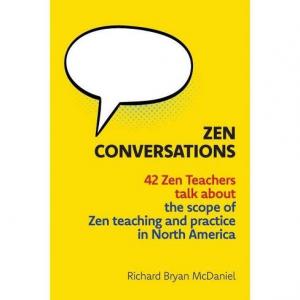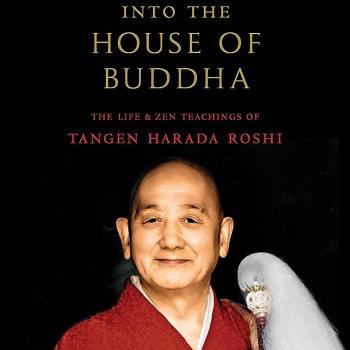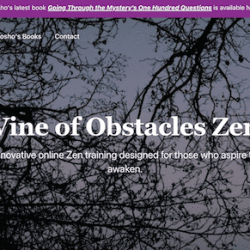
Another baby book has birthed and is making their way the world. In this case, it’s Rick McDaniel’s new book that’s out there, ready to be read. You’ll find it here: click. Zen Conversations includes a section by yours truly, see below, and features a rare section by Tetsugan Sensei, my wife, best friend, and teaching partner.
If you follow the click, you’ll also find fourteen blurbs by Zen teachers – now that’s one well-blurbed book! These blurbs represent a really wide range of Zen teachers, which is also what you’ll find in the book – a wide range of opinions about key issues in Zen practice. Indeed, the array of views might be confusing. After all, if there is this thing called Zen, then shouldn’t there be more commonality about what the heck it is?
That seems reasonable, but apparently, Zen doesn’t mind having many voices. What is the one voice?
Here’s the blurb I wrote: “In Zen Conversations, Rick McDaniel captures the voice of American Zen. It comes through as if there were one voice whispering through all the many voices chronicled here and through all the various views about practice and awakening. Rick’s extraordinary interviewing skills stand out through these many Zen teachers. He himself is almost absent, while his subjects shine through on page after page. A delightful read.”
Beyond the blurb, below you’ll find the portion of Zen Conversations that I contributed. In addition to sharing a little section in hope that might lead you to buy the book, I’m posting this because it strikes me as a pretty clear expression of my opinion – that if a Zen student’s intention is to realize the same mind as Buddha and live accordingly, koan work is more effective for most householders than just-sitting. I hope this might stimulate some conversations about best practice standards for meditation techniques, especially among Zen teachers.
We teachers have best practice standards in other areas – governance and ethics, for example – so why not have best practice standards for the heart of Zen?
I invite you to take a look at this. If you are so moved, share your opinion on the Facebook page where you found this (not Disqus, please).
If you’re interested in reflecting on the Zen movement in the West (especially the US and Canada), or if you’re looking for a teacher and would like to see them in the context of an array of other teachers, I encourage you to buy Rick’s book.
Here’s the excerpt:
Since Albert Low’s death, Dosho Port is the teacher with whom I’ve continued playing with koans. He is a Dharma heir of both Dainin Katagiri and James Ford, and his training with Katagiri was in the Soto tradition where the focus is on monastic life and shikan taza – which Dosho prefers to refer to by the English rendering “just-sitting” – rather than on koan study. It was Katagiri’s wish, however, that Dosho spend some time practicing in Japan, and, while there, he was introduced to koan work.
“I think the purpose of koan introspection and just-sitting combined with dignified behavior, the way it’s taught in Soto monasticism, are the same,” he tells me. “But if the goal is to realize the same mind as Buddha and live accordingly – or ‘to practice awakening’ as Dogen put it – koan work is more effective for most householders than just-sitting, and, despite the continuing prevalence and power of the monastic narrative within Western Zen, about 99% of Zen students are householders.
“What Harada Daiun Roshi and Yasutani Roshi did in the 20th century was simplify the Rinzai koan curriculum so that it was portable, so that practicing awakening as a householder was within reach of anyone who approached the work with persistence and skilled guidance. I don’t know that making it available to householders was their intention. It could be that they were just trimming the hedge that had grown up since Hakuin’s time, but that simplification, or refocusing, made it possible for English-speaking Westerners to do post-kensho koan training without being Chinese classics scholars.
“At about the same time, Shunryu Suzuki Roshi, Katagiri Roshi, Chino Roshi, and others were here trying to figure out how to teach people how to practice in householder life in the West, and so they simplified dignified-behavior training from the Soto monastic system in a way that was similar to what Harada Roshi and Yasutani Roshi had done with the koan curriculum. But, in my experience, without the monastic container, the impact of dignified-behavior training is rarely as effective as the koan curriculum. It just isn’t as obviously portable.
“Saying this doesn’t make me very popular in some Soto circles, but that’s my experience as a student and as a teacher, first as a teacher in the Soto system for twenty years and now as a teacher of the Harada-Yasutani koan curriculum for about ten. Without koan training, people can certainly have deep belief in the efficacy of the Buddhadharma, but it’s rare to actually taste the truth of Zen in their life without some kind of koan work. It’s possible, of course, and I’ve met about a dozen students, some of whom also started with Katagiri Roshi, who I’m convinced had clear kensho experiences while practicing just-sitting. But even if someone living as a householder has a first kensho, there isn’t a system within Soto Zen in the West, at least outside of the few Soto monasteries here, that can help people move through and beyond the first opening. And post-kensho integration is really the more important part of training. Within the koan curriculum there are hundreds of barrier koans to pass through as exercises in the ‘how to’ of vividly practicing awakening – actually integrating the kensho experience within the nitty gritty details of the life the person is living.”
 Dōshō Port began practicing Zen in 1977 and now co-teaches with his wife, Tetsugan Zummach Ōshō, with the Vine of Obstacles: Online Support for Zen Training, an internet-based Zen community. Dōshō received dharma transmission from Dainin Katagiri Rōshi and inka shōmei from James Myōun Ford Rōshi in the Harada-Yasutani lineage. Dōshō’s translation and commentary on The Record of Empty Hall: One Hundred Classic Koans, is now available (Shambhala). He is also the author of Keep Me In Your Heart a While: The Haunting Zen of Dainin Katagiri.
Dōshō Port began practicing Zen in 1977 and now co-teaches with his wife, Tetsugan Zummach Ōshō, with the Vine of Obstacles: Online Support for Zen Training, an internet-based Zen community. Dōshō received dharma transmission from Dainin Katagiri Rōshi and inka shōmei from James Myōun Ford Rōshi in the Harada-Yasutani lineage. Dōshō’s translation and commentary on The Record of Empty Hall: One Hundred Classic Koans, is now available (Shambhala). He is also the author of Keep Me In Your Heart a While: The Haunting Zen of Dainin Katagiri.











